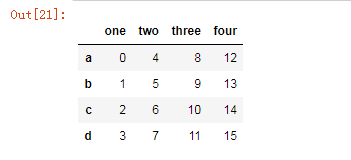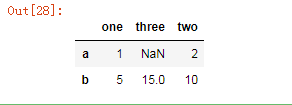创建DateFrame的常用四种方式
一.使用numpy创建

二.由Series组成的字典

自定义行索引;

总结:
由Series组成的字典,创建Dataframe, columns为字典key, index为Series的标签(如果
Series没有指定标签,则默认数字标签)
三.由字典或者series组成的列表

输出为:
指定行索引,列名:

总结:
由字典组成的列表创建Dataframe, columns为字典的key, index不做指定默认为数字标签,
pandas会自动为行,列索引排序;但是如果在pd.dataframe()的参数中指定了index和columns的值,行和列的索引就会按照指定的值排列
四.由字典组成的字典

总结:
字典的健值作为dataframe的columns
如果没有指定index参数的值,行索引使用默认的数字索引
每个序列的长度必须相同
同样的,pandas会对会对列索引排序,如果显示的传入columns参数,将按照传入的值得顺序显示
__EOF__
作 者:Hichens
出 处:https://www.cnblogs.com/hichens/p/11447523.html
关于博主:莫得感情的浅度学习机器人
版权声明:@Hichens
声援博主:如果您觉得文章对您有帮助,可以点击文章右下角【推荐】一下。您的鼓励是博主的最大动力!



【推荐】国内首个AI IDE,深度理解中文开发场景,立即下载体验Trae
【推荐】编程新体验,更懂你的AI,立即体验豆包MarsCode编程助手
【推荐】抖音旗下AI助手豆包,你的智能百科全书,全免费不限次数
【推荐】轻量又高性能的 SSH 工具 IShell:AI 加持,快人一步
· AI与.NET技术实操系列:向量存储与相似性搜索在 .NET 中的实现
· 基于Microsoft.Extensions.AI核心库实现RAG应用
· Linux系列:如何用heaptrack跟踪.NET程序的非托管内存泄露
· 开发者必知的日志记录最佳实践
· SQL Server 2025 AI相关能力初探
· 震惊!C++程序真的从main开始吗?99%的程序员都答错了
· winform 绘制太阳,地球,月球 运作规律
· 【硬核科普】Trae如何「偷看」你的代码?零基础破解AI编程运行原理
· 上周热点回顾(3.3-3.9)
· 超详细:普通电脑也行Windows部署deepseek R1训练数据并当服务器共享给他人